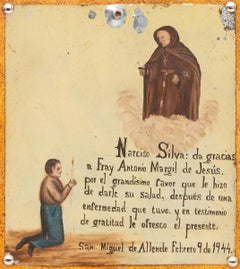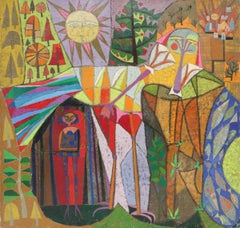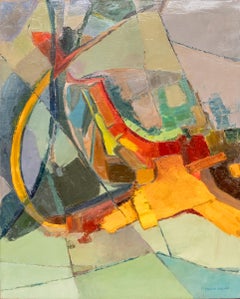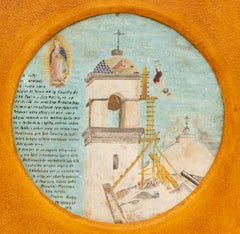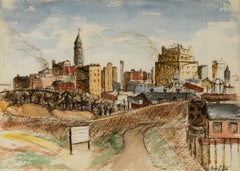David Cook Galleries
to
41
317
176
58
36
35
33
28
26
26
24
16
16
15
8
7
6
4
3
3
2
1
16
16
6
6
6
Period: Mid-20th Century
1940s Ex Voto; Holy Tribute for the Return of Good Health, Retablo Painting
Located in Denver, CO
Ex Voto; Holy Tribute for the Return of Good Health. Oil on tin with ink, February 9, 1944, anonymous Mexican artist with a contemporary custom frame hand-carved by artisan Michael B...
Category
1940s Folk Art Figurative Paintings
Materials
Oil
The Phoenix – 1960s Mid-Century Abstract Art with Figures, Trees & Sun
By Edward Marecak
Located in Denver, CO
An original vintage 1960s semi-abstract painting by celebrated Colorado artist Edward Marecak, titled "The Phoenix." This dynamic composition bursts with expressive energy, rendered ...
Category
1960s Abstract Impressionist Abstract Paintings
Materials
Oil
1960s Mid-Century Abstract Expressionist Oil Painting in Primary Colors
By Florence Graziano
Located in Denver, CO
This original 1960s oil on canvas by American artist Florence V. Mercolino Graziano exemplifies the dynamic energy of the Abstract Expressionist movement. The composition showcases b...
Category
1960s Abstract Expressionist Abstract Paintings
Materials
Oil
1930s Mexican Ex Voto Retablo – Healing Miracle After Fall from Church Tower
Located in Denver, CO
An extraordinary example of Mexican devotional folk art, this 1934 oil and ink painting on tin—known as an Ex Voto—depicts a miraculous healing following a life-threatening fall from...
Category
1930s Folk Art Figurative Paintings
Materials
Metal
1950s Denver Skyline Painting – Graphite & Watercolor Colorado Cityscape Art
Located in Denver, CO
A captivating midcentury cityscape titled "Denver Skyline", this original 1950s watercolor and graphite painting offers a rare industrial-era view of lower downtown Denver, Colorado....
Category
1950s American Impressionist Landscape Paintings
Materials
Watercolor, Graphite
Witches Entrance 1960s Abstract Geometric Composition, Figures in Red Green Blue
By Edward Marecak
Located in Denver, CO
A dynamic and boldly imaginative work by celebrated mid-century Denver artist Edward Marecak, "Witches Entrance" is an original abstract painting dating to the 1960s. Rich in color a...
Category
1960s Abstract Geometric Mixed Media
Materials
Oil Pastel, Acrylic
"Metamorphosis" Mid-Century Abstract Painting by Pawel Kontny, Textured 1960s
By Pawel Kontny
Located in Denver, CO
Discover the striking beauty of “Metamorphosis,” an original abstract painting by celebrated mid-century artist Pawel Kontny (also known as Paul Kontny). Created in the late 1960s to...
Category
1960s Abstract Mixed Media
Materials
Marble
House in the Sun, 1950s Modernist Black & White Lithograph of New Mexico Adobe
By Kenneth Miller Adams
Located in Denver, CO
House in the Sun is an original 1950 lithograph by renowned New Mexico modernist Kenneth Miller Adams. This striking black and white composition captures the timeless geometry and su...
Category
1950s American Modern Landscape Prints
Materials
Lithograph
Frost Flowers, 1960s Mid-Century Pastel & Ink Drawing in Grayscale Tones
By Edward Marecak
Located in Denver, CO
Frost Flowers is an original circa 1965 mixed media drawing by celebrated Denver-based artist Edward Marecak. Executed in pastel and ink on paper, thi...
Category
1960s Abstract Abstract Drawings and Watercolors
Materials
Oil Pastel, Ink
Cosmos, 1960s Mid-Century Abstract Mixed Media Art in Brown and Blue Tones
By Pawel Kontny
Located in Denver, CO
Cosmos is an original mid-century abstract painting by Polish-American artist Pawel Kontny (also known as Paul Kontny), created in the 1960s. This striking mixed media work is compos...
Category
1960s Abstract Expressionist Abstract Paintings
Materials
Marble
Red Rocks Park 1930s Oil Painting – Snow-Capped Mountain Landscape Artwork
Located in Denver, CO
"Red Rocks Park" – an original circa 1935 oil painting by noted Denver artist Eula Ray, capturing a serene winter landscape of the iconic Red Rocks of Colorado. Rendered in oil on bo...
Category
1930s American Impressionist Landscape Paintings
Materials
Oil
After Storm, San Cristobal Valley Ranch, Taos-Questa Road (Santa Fe, New Mexico)
Located in Denver, CO
“After Storm, San Cristobal Valley Ranch, Taos-Questa Road, Santa Fe, New Mexico” — a captivating original oil on canvas landscape painting, created in January 1968. This vintage wor...
Category
1960s American Impressionist Landscape Paintings
Materials
Oil
Midcentury Modern Biomorphic Carved Wood Sculpture, Table Top Abstract Art
By Edward Chavez
Located in Denver, CO
Striking mid-20th century abstract biomorphic sculpture by American artist Eduardo Chavez, expertly carved from what is likely cherry wood. This vintage piece showcases smooth, flowi...
Category
Mid-20th Century Abstract Abstract Sculptures
Materials
Wood
Red Mountain Relic (View of Red Mountain, Colorado), Signed Black & White Print
By Gene Kloss
Located in Denver, CO
A stunning example of American printmaking, “Red Mountain Relic” is an original etching with drypoint by acclaimed artist Gene Kloss (1903–1996). This atmospheric composition capture...
Category
Mid-20th Century American Modern Landscape Prints
Materials
Etching
1930s Brussels Harbor Scene - Original Acrylic Seascape Painting with Boats
Located in Denver, CO
Experience the charm and maritime beauty of 1930s Brussels with this stunning original vintage harbor scene by acclaimed artist Carl Rabus. Painted in ...
Category
1930s Expressionist Landscape Paintings
Materials
Acrylic
Modernist Woman Portrait - Original Acrylic Painting with Rich Green Background
Located in Denver, CO
Discover a striking original modernist portrait by Eunice Katz (1927–2008). This captivating acrylic painting on board features a woman’s portrait, rendered in a bold palette of rich...
Category
Mid-20th Century American Modern Portrait Paintings
Materials
Acrylic
Homage to E.W. (Emerson Woelffer), Original Mid Century Modern Lithograph
Located in Denver, CO
Discover a stunning vintage original lithograph by renowned Colorado Springs artist Mary Chenoweth. This striking abstract composition features bold geometric shapes set against a vi...
Category
Mid-20th Century Abstract Abstract Prints
Materials
Lithograph
Shovel Handles, 1950s Framed American Modernist Oil Painting, Green Bronze Blue
By Paul Kauvar Smith
Located in Denver, CO
"Shovel Handles" is an original 1953 semi-abstract modernist oil painting on board by renowned Denver artist Paul K. Smith (1893-1977). This captivating piece showcases Smith’s signa...
Category
1950s American Modern Figurative Paintings
Materials
Oil
Datura Stramonium, 20th Century Still Life Watercolor with Flowers in a Vase
By Werner Drewes
Located in Denver, CO
This original vintage watercolor painting, titled "Datura Stramonii," is a stunning work by renowned American abstractionist Werner Drewes. The composition captures the delicate beau...
Category
Mid-20th Century American Impressionist Still-life Drawings and Watercolors
Materials
Watercolor
Ex Voto Holy Tribute for the Healing of a Son, 1940s Ink & Paint Metall Retablo
Located in Denver, CO
This authentic Mexican ex-voto is a heartfelt tribute of gratitude, painted in oil on tin with ink circa 1940 by an anonymous Mexican artist. It is beautifully framed in a hand-carve...
Category
1940s Folk Art Figurative Paintings
Materials
Metal
"Birth" 1940s Surrealist Abstract Watercolor Painting, Gray Scale Female Figure
By Charles Ragland Bunnell
Located in Denver, CO
"Birth" is a striking semi-abstract watercolor painting created by the talented Colorado artist, Charles Ragland Bunnell, in 1943. The artwork, crafted during Bunnell's Black and Blu...
Category
1940s Surrealist Figurative Paintings
Materials
Watercolor
Lush Grazing, North Park (Colorado) Rocky Mountain Landscape Oil Painting
By James Emery Greer
Located in Denver, CO
Immerse yourself in the breathtaking beauty of the Rocky Mountains with Lush Grazing, North Park, an original oil painting by renowned landscape artist James Emery Greer, created in ...
Category
Mid-20th Century Abstract Impressionist Landscape Paintings
Materials
Oil
1940s Impressionist Oil Painting – Three Bathing Female Figures, Original Art
Located in Denver, CO
Step into a world of serenity and natural beauty with "Three Bathers," a captivating vintage 1940s oil painting on board by renowned Colorado artist Morgan Wagner. This exquisite art...
Category
1940s American Impressionist Portrait Paintings
Materials
Oil
1930s WPA Era Watercolor Painting of Horses in a Southwest Landscape
By Lloyd Moylan
Located in Denver, CO
Immerse yourself in the beauty of the American Southwest with this stunning vintage painting by renowned artist Lloyd Moylan (1893–1963). This masterful watercolor and gouache on pap...
Category
1930s American Modern Animal Drawings and Watercolors
Materials
Watercolor, Gouache
Jenny Lake, Estes Park – 1950s Mid-Century Rocky Mountain Landscape Oil Painting
Located in Denver, CO
Immerse yourself in the breathtaking beauty of the Rocky Mountains with this stunning mid-century oil painting by renowned artist Clarence Durham. Capturing the tranquil waters of Jenny Lake...
Category
1950s American Impressionist Landscape Paintings
Materials
Oil
Rocky Shore – 1960s Abstract Seascape Oil Painting in Vibrant Green & Blue Tones
Located in Denver, CO
Experience the energy and beauty of the coastline in Rocky Shore (1967), a stunning original oil painting on canvas by acclaimed artist Ann Sink (1924-2019). This vibrant abstract se...
Category
1960s Abstract Expressionist Abstract Paintings
Materials
Oil
Original Impasto Abstract Mid-Century Modern Oil Painting, Framed Blue & Red Art
Located in Denver, CO
Experience the bold elegance of Wilma Fiori's original abstract oil painting, a striking composition by the renowned Denver artist (1929-2019). This mid-century modern masterpiece fe...
Category
Mid-20th Century Abstract Expressionist Abstract Paintings
Materials
Oil
Sheep, Storm, South Park, Colorado (Sheep grazing on a Colorado plain)
By Myron Wood
Located in Denver, CO
Capture the timeless beauty of the American West with this vintage 1960s photograph by renowned photographer Myron Wood. Titled "Sheep, Storm, South Park, Colorado", this stunning bl...
Category
1960s American Modern Black and White Photography
Materials
Photographic Film
1950s Signed New Mexico Winter Lithograph – Original Vintage Snowy Landscape Art
By Kenneth Miller Adams
Located in Denver, CO
Step into the serene beauty of a New Mexico winter with this stunning 1950s signed lithograph, New Mexico Village Under Snow, by acclaimed artist Kenneth Miller Adams. This rare vint...
Category
1950s American Modern Landscape Prints
Materials
Lithograph
The Train, Vintage Vibrant Folk Art Oil Painting with Bold Colorful Details
By Martin Saldana
Located in Denver, CO
Discover the vibrant world of Martin Saldana, a talented Mexican-American folk artist known for his captivating rustic and naïve style. This original painting, titled "The Train", wa...
Category
1950s Folk Art Abstract Paintings
Materials
Oil
Colorado Mining Town, Early Sunday Morning - Modernist Mountain Landscape
By Paul Kauvar Smith
Located in Denver, CO
This captivating original mountain landscape by the talented Paul K. Smith brings to life the beauty and historical charm of Colorado’s mining heritage. Painted in the 1930s-1950s, the artwork likely depicts one of Colorado's iconic historic mining towns...
Category
1930s American Modern Landscape Paintings
Materials
Oil
Original Mid-Century Modern Abstract Gouache Painting by Taos Artist Louis Ribak
By Louis Ribak
Located in Denver, CO
Experience the bold elegance of Louis Leon Ribak's original mid-century modern abstract painting, a striking composition by the renowned Taos, New Mexico artist. This captivating gou...
Category
Mid-20th Century Abstract Abstract Paintings
Materials
Gouache
1960s Mid Century Modern Desert Landscape Acrylic Painting in Rich Earth Tones
Located in Denver, CO
This captivating 1960s abstract painting, titled "Desert Landscape," is a striking original work by acclaimed New Mexico and Colorado artist Ann Sink. The composition beautifully cap...
Category
1960s Abstract Expressionist Abstract Paintings
Materials
Acrylic
1940s WPA Era American Modern Colorado Mountain Landscape Watercolor Painting
Located in Denver, CO
This original watercolor painting by American artist Edgar Britton captures the serene beauty of a Colorado mountain landscape. Created in 1946, this piece showcases soft, airy tones...
Category
1940s American Modern Landscape Drawings and Watercolors
Materials
Watercolor
Moonrise Over Colorado Springs: 1950s Abstract Oil Painting Green, Blue & Ochre
By Charles Ragland Bunnell
Located in Denver, CO
"Moonrise Over Colorado Springs" is a striking 1950s abstract expressionist oil painting by renowned artist Charles Ragland Bunnell. Created in 1952, this captivating piece features ...
Category
1950s Abstract Abstract Paintings
Materials
Oil
Vibrant Geometric Abstract with Circles - Mid 20th Century Oil Painting Artwork
Located in Denver, CO
This striking vintage 20th-century abstract painting, created by talented Colorado Springs artist Mary Chenoweth, offers a dynamic geometric design highlighted by bold, vibrant circl...
Category
Mid-20th Century Abstract Geometric Abstract Paintings
Materials
Oil
1935 Snowy Town Grove Winter Landscape Oil Painting - Vintage Winter Art
By Robert Amick
Located in Denver, CO
This original circa 1935 oil painting by acclaimed Colorado artist Robert Wesley Amick captures a serene winter scene in a quiet town grove. The composition depicts a peaceful moment...
Category
1930s American Impressionist Landscape Paintings
Materials
Oil
1953 Signed Black & White Etching Print 'Ceremonial Day at Taos' New Mexico
By Gene Kloss
Located in Denver, CO
"Ceremonial Day at Taos" is a captivating vintage black and white etching by renowned American artist Gene Kloss. Created in 1953, this drypoint etching depicts the vibrant life of T...
Category
1950s American Modern Landscape Prints
Materials
Etching
Mid-Century Abstract Mixed Media 'Transfiguration' Composition with Marble Dust
By Pawel Kontny
Located in Denver, CO
"Transfiguration" is a captivating original abstract painting by the talented artist Pawel Kontny (also known as Paul Kontny), created during the mid-20th century. This unique composition was crafted using a combination of marble dust, gesso, and oil glaze on masonite, resulting in a striking raised texture that adds depth and dimension to the artwork. The use of marble dust and gesso gives the piece a rich, tactile quality, making it visually stunning.
The painting is rendered in a harmonious palette of neutral tones, including shades of brown, beige, yellow, and grey, creating a subtle yet powerful interplay of light and shadow. These muted hues evoke a sense of calm and contemplation, allowing the viewer to immerse themselves in the abstract forms and textures that dominate the canvas.
This piece is presented in its original black and gold frame, which enhances its vintage charm and complements the sophisticated color palette. "Transfiguration" is an exceptional work of art, perfect for collectors of mid-century abstract art...
Category
1960s Abstract Mixed Media
Materials
Marble
Man In His Search for God, 1939 WPA Era Original Grey Scale Gouache Painting
By Charles Ragland Bunnell
Located in Denver, CO
This striking vintage 1939 original painting, titled Man In His Search for God, is a powerful piece from Charles Bunnell’s renowned Black and Blue Series. The artwork is painted in i...
Category
1930s Futurist Figurative Paintings
Materials
Gouache
Riding the Brahmas (Man Riding a Bull) - Signed Original 20th Century Lithograph
By Ethel Magafan
Located in Denver, CO
This original modernist lithograph, titled Riding the Brahmas, is a dynamic work by esteemed Colorado artist Ethel Magafan. The lithograph depicts a dramatic scene of a man riding a ...
Category
Mid-20th Century American Modern Animal Prints
Materials
Lithograph
1960s Abstract Serigraph in Gray, Black, White with Red Moon, Vintage Modern Art
By Thomas W. Benton
Located in Denver, CO
This striking vintage original serigraph, created by renowned Aspen artist Thomas Whelan Benton, features a bold composition of a white snowflake set against a dramatic black field, ...
Category
1960s Abstract Abstract Prints
Materials
Screen
"Bird #2" - 1949 Vintage Black & White Modernist Monotype Print by Edgar Britton
Located in Denver, CO
Bird #2 is a striking vintage black-and-white monotype print by renowned Colorado artist Edgar Britton. Created in 1949, this original work features a bold composition of a white dov...
Category
1940s American Modern Animal Prints
Materials
Monotype
Original 1940s Retrofuturism Gouache Painting 'Birth of Mind' in Black & White
By Charles Ragland Bunnell
Located in Denver, CO
This vintage 1940s gouache painting, titled Birth of Mind, is a striking example of retrofuturism by Charles Ragland Bunnell, a prominent artist from the Broadmoor Academy...
Category
1940s Futurist Abstract Drawings and Watercolors
Materials
Gouache
Original Naïve Folk Art Oil Painting by Martin Saldaña – Whimsical Girl, Flowers
By Martin Saldana
Located in Denver, CO
This enchanting original oil painting, Pinky, is a beautiful example of whimsical Naïve folk art by the artist Martin Saldaña. The artwork features a charming portrait of a young gir...
Category
1950s Folk Art Figurative Paintings
Materials
Oil
Waterfall: Abstract Pastel by Taos Artist Emil James Bisttram in Earth Tones
Located in Denver, CO
Waterfall, is a stunning original pastel artwork by celebrated Taos artist Emil James Bisttram, is a captivating example of abstract expressionism. Featuring neutral earth tones like...
Category
Mid-20th Century Abstract Abstract Drawings and Watercolors
Materials
Oil Pastel
1960s Abstract Painting by New Mexico Modernist Artist - Vibrant Yellow, Orange
By Ward Lockwood
Located in Denver, CO
This vintage 1960s abstract painting by renowned New Mexico modernist artist Ward Lockwood (1894–1963) is an exceptional example of mid-century modern art. The original artwork, crea...
Category
1960s Abstract Expressionist Abstract Drawings and Watercolors
Materials
Mixed Media, Ink, Gouache
1940s Western Mountain Landscape Oil Painting – Snowy Peaks, American West
By Turner Messick
Located in Denver, CO
This original oil painting by Turner B. Messick (1878–1952) captures a serene Western mountain landscape, likely set in California or Colora...
Category
1940s American Impressionist Landscape Paintings
Materials
Oil
"Demeter and Persephone" – 1960s Vintage Figural Abstract Oil Painting
By Edward Marecak
Located in Denver, CO
This captivating 1960s vintage oil painting, Demeter and Persephone, is an original, signed work by celebrated mid-20th-century Denver artist Edward Marecek (1919–2004). Inspired by ...
Category
Mid-20th Century Abstract Portrait Paintings
Materials
Oil
Mid-Century Modern Abstract Ink & Acrylic Painting in Green, Brown & White Tones
By Edward Marecak
Located in Denver, CO
This striking ink and acrylic on paper abstract artwork, titled Mystic Writing, was created by acclaimed Denver artist Edward Marecak (1919-1993). Featuring mystical symbols enclosed...
Category
Mid-20th Century Abstract Mixed Media
Materials
Ink, Acrylic
1960s Mexican-American Folk Art Oil Painting, Girl on Swing, Birds, Bright Color
By Martin Saldana
Located in Denver, CO
This vibrant 1950s-1960s oil painting by renowned Mexican-American folk artist Martin Saldaña (1874–1965) depicts a whimsical outdoor scene with a young girl on a swing, accompanied ...
Category
Mid-20th Century Folk Art Landscape Paintings
Materials
Oil
"Looming Bluff" 1960s Mid-Century Modern Abstract Expressionist Oil Painting
Located in Denver, CO
This stunning vintage 1960s Mid-Century Modern oil on canvas abstract expressionist painting by Walter Blakelock Wilson (1929-2011) showcases a vibrant array of jewel-toned hues. Rich Sapphire blue, emerald green, golden yellow, amber, reddish brown, and hints of gold contrast beautifully with neutral shades of tan, creamy white, olive, and beige. The work also features tones of orange, red, teal blue, gray, camel, and white, all blending seamlessly to create a dynamic, multi-dimensional visual experience. Signed and dated “W.B. Wilson '62”, this masterpiece is presented in an elegant custom gold leaf frame, with outer dimensions of 45 ½ x 37 ½ inches and a canvas size of 43 ¼ x 35 ¼ inches.
About the Artist: Walter Blakelock Wilson, born in 1929 in Auburn...
Category
Mid-20th Century Abstract Expressionist Abstract Paintings
Materials
Oil
1950s Western Mountain Landscape Oil Painting "Little Bear" Framed Art
By Harold Vincent Skene
Located in Denver, CO
"Little Bear" is a captivating mid-century oil painting by American artist Harold Vincent Skene (1883–1978). This traditional Western landscape, painted in...
Category
Mid-20th Century American Impressionist Animal Paintings
Materials
Oil
1950s Soquel California Barns Landscape, Vintage Oil Painting, Blue Green Red
By Jon Blanchette
Located in Denver, CO
Charming mid-century oil painting by noted California artist Jon Blanchette (1908–1987), titled "Barns in Soquel." This original, signed work is painted on canvas board and captures ...
Category
Mid-20th Century American Impressionist Landscape Paintings
Materials
Oil
Mendocino Hippies, 1960s Framed Northern California Landscape Tents & Figures
By Jon Blanchette
Located in Denver, CO
California, titled Mendocino Hippies. Depicting a peaceful camp scene with tents nestled under a grove of trees, the artwork features calming tones of green, blue, white, golden yell...
Category
Mid-20th Century American Impressionist Landscape Paintings
Materials
Oil
20th Century Plein Air Impressionist Northern California Landscape, Farmhouse
By Jon Blanchette
Located in Denver, CO
Original Mid 20th Century Northern California Landscape Painting by Jon Blanchette (1908-1987). This vintage plein air style painting depicts a serene rural scene with a white farmho...
Category
Mid-20th Century American Impressionist Landscape Paintings
Materials
Oil
Large 1960s Modernist Bicycle Oil Painting by Mary Chenoweth – Postmodern Art
Located in Denver, CO
This striking large-format oil painting on canvas by renowned 20th-century Colorado artist Mary Chenoweth dates to the 1960s and exemplifies the bold sp...
Category
Mid-20th Century Modern Abstract Paintings
Materials
Oil, Canvas
1940s Modernist Mountain Landscape Painting- Gunnison, Western Colorado
Located in Denver, CO
Charming 1940s modernist mountain landscape painting featuring a white farmhouse, outbuildings, and trees set in a verdant meadow near Gunnison, on the western slope of Colorado. Maj...
Category
1940s American Impressionist Landscape Paintings
Materials
Oil
1930s American Modernist Colorado Winter Landscape Watercolor, Trees, Mountains
Located in Denver, CO
This 1938 watercolor painting by American Modernist artist Turner B. Messick depicts a serene winter landscape, likely set in Colorado. The scene features a bare tree in the foregrou...
Category
1930s American Modern Landscape Paintings
Materials
Watercolor
Winter Palace, 1960s Mid Century Modern Abstract Watercolor & Acrylic Painting
By Edward Marecak
Located in Denver, CO
Winter Palace is a stunning abstract acrylic and watercolor painting on paper by 20th Century Denver artist Edward Marecak (1919-1993). Created circa the 1960s, the artwork features ...
Category
1960s Abstract Abstract Drawings and Watercolors
Materials
Mixed Media, Acrylic, Watercolor
